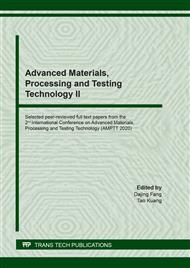[1]
R. Naslain. Design, preparation and properties of non-oxide CMCs for application in engines and nuclear reactors: an overview, Compos. Sci. Techonl. 64 (2004) 155-170.
DOI: 10.1016/s0266-3538(03)00230-6
Google Scholar
[2]
Z. Su, L. Zhang, Y. Li, etal. Rapid preparation of SiC fibers using a curing route of electron irradiation in a low oxygen concentration atmosphere, J. Am. Ceram. Soc. 98 (2017) 2014-2017.
DOI: 10.1111/jace.13649
Google Scholar
[3]
M.Wang, Z.G. Dong et al. Application of Continuous Fiber Reinforced Ceramic Matrix Composites in Aeroengine, Aero. Manuf. Technol. 6 (2014) 10-13.
Google Scholar
[4]
L.T. Zhang, L.F. Cheng. Discussion on strategies of sustainable development of continuous fiber reinforced ceramic matrix composites, Acta. Mater. Compos. Sin. 24 (2007) 1-6.
Google Scholar
[5]
J. J. Sha, T. Hinoki, AM.and A. Kohy. Microstructure and mechanical properties of Hi-Nicalon™ Type S fibers annealed and crept in various oxygen partial pressures, Mater. Charct. 60(2009) 796–802.
DOI: 10.1016/j.matchar.2009.01.017
Google Scholar
[6]
A. R. Bunsell, A.Piant. A review of the development of three generations of small diameter silicon carbide fibers, J. Mater. Sci. 41 (2006) 823-839.
DOI: 10.1007/s10853-006-6566-z
Google Scholar
[7]
A. Younes, A. Seidel, T. Engler, et al. Mechanical behavior of carbon and glass filament yarns under high temperatures for composites applications, J.Text. I. 104 (2013) 251-259.
DOI: 10.1080/00405000.2012.717752
Google Scholar
[8]
G. S. Bibbo, P. M. Benson, C. G. Pantano. Effect of carbon monoxide partial pressure on the high-temperature decomposition of Nicalon fiber, J. Mater. Sci. 6 (1991) 5075-5080.
DOI: 10.1007/bf00549894
Google Scholar
[9]
D. J. Pysher, K. C. Goretta, R. S. Hodder, et al. Strength of ceramic fibers at elevated temperature, J. Am. Ceram. Soc. 72 (1998) 284-288.
Google Scholar
[10]
T. Mah, N. L. Hecht, H. M. Kim, et al. Thermal stability of SiC fibres (Nicalon), J. Mater. Sci. 19 (1984) 1191-1201.
DOI: 10.1007/bf01120029
Google Scholar
[11]
T. J. Clark, M. Jaffe, J. Rabe, et al. Thermal Stability Characterization of SiC Fiber: I, Mechanical Property and Chemical Structure Effects, Ceram. Eng. Sci. Proc. 7(1986) 901-913.
Google Scholar
[12]
ZH. M.SU, L.F. Chen. Effect of heating treatment on microstructure and property of NL 202 SiC fiber, J. Funct. Mater. 46 (2015) 23-26.
Google Scholar
[13]
F.C. Wang. Modern analysis and testing methods for materials, BIT, Beijing, (2005).
Google Scholar
[14]
J. J. Fan, Z. D. Chang, C. H. Tao. Research progress of failure analysis of EBCs, Fail. Anal. Prev. 12 (2017) 386-390.
Google Scholar


